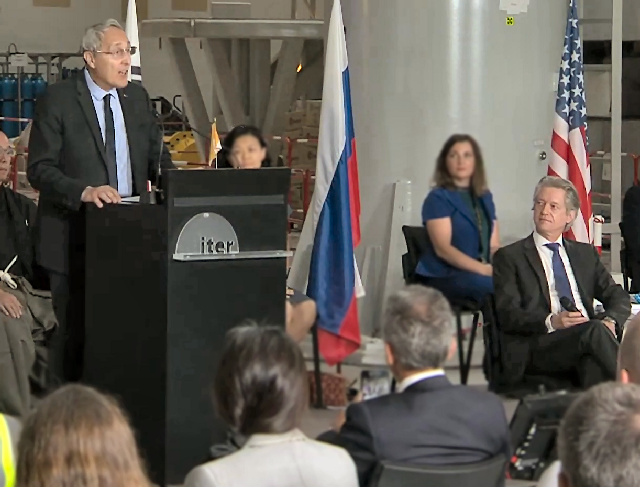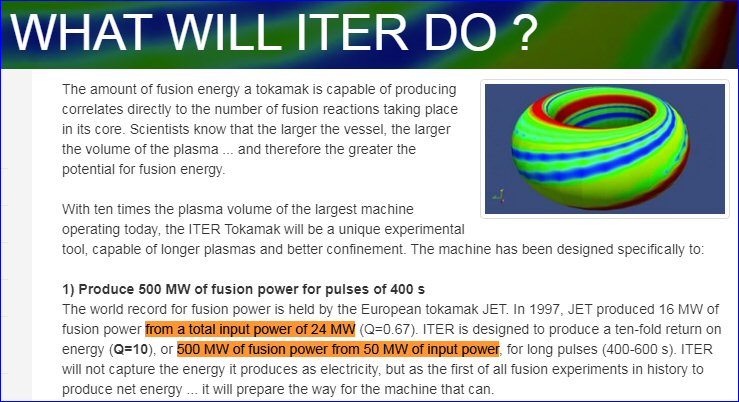#86 ITER Timeline Delayed Again: First Experiments Most Likely in 2031
Return to ITER Power Facts Main Page
By Steven B. Krivit
Oct. 26, 2021
In ten years, the ITER schedule has fallen ten years behind schedule.
Bernard Bigot, the director-general of the ITER organization, will provide an official notice of another construction delay to its governing body, the ITER Council, at its meeting in November, according to multiple sources who have spoken with New Energy Times.
But the ITER project timeline is further behind than the organization will be disclosing publicly — even to the ITER Council, an ITER organization staff member told New Energy Times. The employee requested anonymity because they were not authorized to speak on behalf of the organization.
When construction on ITER, the International Thermonuclear Experimental Reactor, is complete, experiments with test fuels — hydrogen and deuterium — are scheduled to begin. This milestone is known as “first plasma.” These test experiments are slated to run for seven years, until scientists feel confident enough to add radioactive tritium to the fuel mixture.
After two years of running experiments with deuterium-tritium fuel, the team hopes to increase the input power and achieve the reactor’s maximum power gain design value.
According to the source, three potential dates for first plasma appear in internal ITER organization documents, along with the following annotations:
2027: Not Realistic, Not Achievable
2029: Realistic, Optimistic
2031: Realistic, Achievable
New Energy Times is therefore adjusting our projected timeline (according to ITER staff, not management) yet again.
Evasive Answer
In 2006, first plasma had been planned for 2016. By 2012, it was delayed to 2020. In 2014, Nature reporter Elizabeth Gibney spoke with Osamu Motojima, the previous director-general, about the schedule. Gibney had heard rumors that people were talking openly about 2022 or 2023.
She asked Motojima for a new, realistic date for first plasma. He gave an evasive answer. She asked again and mentioned the 2022 and 2023 dates.
“There are a lot of rumors,” Motojima said. “I have the target date, but I need to demonstrate that we can do it with a high-enough probability. It will be around 2022 or 2023, and I will report to the ITER council next June. If the date is 2025, the project will never survive.”
The project did survive, but Motojima’s appointment did not. On March 5, 2015, the ITER Council replaced him with Bigot. When Bigot spoke with Agence France-Presse two months later, he told the news agency that every year of delay adds €200 million to the cost.

Bernard Bigot (at podium) and Laban Coblentz (seated) during 2020 media event
Date Discrepancy
Later in 2015, Science reporter Daniel Clery learned that the official dates for first plasma were “widely acknowledged to be 2025” by everyone except the ITER administration. Clery wrote that the official schedule had been “widely discredited” by then.
False Power Claims
Clery, however, like everyone else, was misled by the ITER management and its fusion promoters to believe that the ITER reactor was designed to “produce 500 megawatts of power from a 50 megawatt input.” If that were true, the ITER reactor would be on track to produce a tenfold gain in power.
In reality, the 50 MW value applies to only the heating power injected into and used to heat the fuel. In reality, the reactor will need at least 500 megawatts to start up, and it will need between 300 and 400 megawatts continuously. (See the New Energy Times ITER Power Research and Analysis here.)
The scientific goal of the project has nothing to do with the power gain of the reactor. The gain applies to only the power gain of the physics reactions. Thus, if the ITER reactor accomplishes its scientific goal, it will produce zero reactor net power and demonstrate zero reactor power gain.
But fusion promoters rarely disclosed this distinction when speaking with the public — or their own representatives. In 2008, when the ITER organization management told Neil Calder, the organization’s first spokesman, that he should tell journalists that the reactor would need only 50 MW of power to generate 500 MW of power, ITER management misinformed him.

False and misleading 2008 statement by Neil Calder, former head of ITER public communications (Source)
“That’s what everyone was saying, that was it, that was the point of ITER,” Calder told New Energy Times. “I spoke to everyone in senior management at the time, and there was no inconsistency, as far as I remember, across the board.”
When the ITER organization claimed for many years on its Web site that the reactor was “designed to produce 500 MW of output power from 50 MW of input power” — without explaining that the 50 MW value applied to only the injected heating power, without explaining that the 50 MW value didn’t include the majority of the input power the reactor will require — its management misinformed everybody.

False claims made by the ITER organization, as published on its Web site, Oct. 5, 2017 (Click here to see ITER organization’s correction soon after Oct. 5, 2017)
When the ITER organization claimed in a 2017 press release that the zero-net-power reactor was supposed to “prove that fusion power can be produced on a commercial scale,” its management again misinformed everybody.
When the ITER organization claimed in a 2020 press release that, if the zero-net-power reactor was connected to the electric grid, its 500 megawatt thermal output “would translate to about 200 megawatts of electric power,” its management again misinformed everybody.
Promoters of ITER and of fusion have been misinforming everybody for decades: using the same formula of conflating fusion reaction power values with fusion reactor power values, understating the power that ITER will need to produce a 500 MW thermal output, and failing to disclose that the 50 MW input value omits the majority of power needed for ITER. They used the same formulaic misrepresentations when telling everyone about the JET reactor result, claiming that the reactor had produced 16 MW of thermal power “from a total input power of 24 MW” instead of 700 MW.

False claims made by the ITER organization, as published on its Web site, before Oct. 6, 2017 (Click here to see ITER organization’s correction soon after Oct. 5, 2017)
The primary measurable objective of the ITER reactor has nothing to do with proving that fusion power can be produced on a commercial scale, contrary to the claims of Laban Coblentz, the current ITER spokesman, in the 2017 press release. It has nothing to do with any theoretical rate of electricity production the reactor might produce, contrary to Coblentz’s statement in the 2020 press release.
Coblentz knew this five years ago. He told New Energy Times on Dec. 22, 2016, that the primary measurable objective of the reactor is to produce “approximately 10 times more power coming out of the plasma than goes into the plasma,” rather than any power gain for the entire reactor.
The Film
ITER is a zero-power experimental fusion reactor concept dishonestly promoted as a 500-megawatt reactor. This April 2021 film documentary tells the story:


